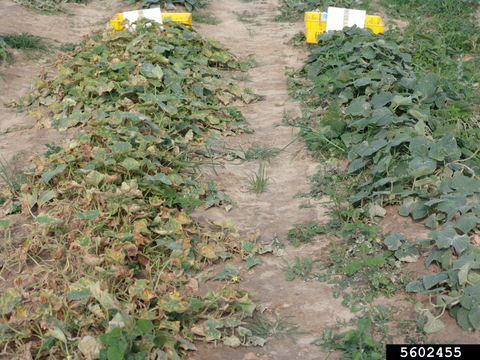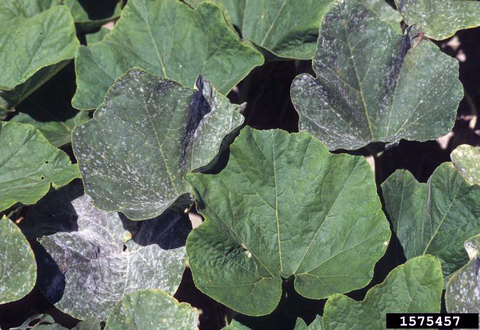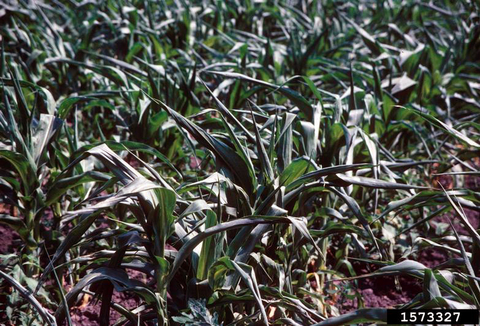You don’t have to be a climatologist to know that this gardening season has been a wild weather ride. The National Weather Service's Climate Prediction Center recently released weather outlooks for July onward. Their models suggest Minnesota will continue to have a warmer than normal summer.
While looking at the future’s weather can be a bit like peering into a crystal ball, how plant diseases work is more clear. For a disease to show up in yard and garden plants, three things need to be present. Plant pathologists refer to this as the disease triangle.
- The host plant.
- The pathogen itself.
- Certain environmental conditions.
Only when these three things are present can plant diseases develop. So what are these three elements, and how might this summer’s weather work out in our favor?
The host plant
"Host" is a fancy word for the thing that the pathogen infects and lives on. Here we are talking about plant hosts, but anything can be a host to other living things. If your dog has tapeworms, the dog is the host of the tapeworm. If a tick is feeding on you, you are host to the tick. If your lilacs have powdery mildew, the lilac plants are the host for the powdery mildew pathogen.
Many plant diseases are limited in what they can infect, typically staying within one plant family. If the host family for a certain plant disease isn’t present, you won’t see that disease in the garden that year.
For example, if your long-standing vegetable garden has been struggling with clubroot in cabbage and broccoli in past years and this year you decided to not plant either, you won’t see clubroot. This is because, without any plants in the brassica family present in the garden, there is no host for the clubroot pathogen to infect.
Resistant varieties can also remove the host plant from the disease triangle. In gardening catalogs, you will see a wide array of disease resistance codes. These are good options for dealing with known or recurring disease issues in the garden.
The pathogen
The pathogen is the organism that infects the host. Plant pathogens are microorganisms (bacteria, fungi, etc.) that can be seen only sometimes when they are making spores, but are oftentimes identified by the symptoms they cause.
Plant pathogens are incredibly diverse, partially because they are often very specific in what hosts they can infect. Most pathogens are able to only infect plants in a certain family.
For example, what is often called powdery mildew is actually many different species. Powdery mildew that you see on lilacs isn’t the same as the powdery mildew that infects your zucchini, which is different from the powdery mildew that infects your ornamental grass. This means that powdery mildew won’t necessarily jump from zucchini to grapes, as they are different pathogen species that infect each plant.
Different pathogens enter an area by different means. Some diseases produce spores that travel on air currents, other diseases can survive on plant debris from the previous year, while others are able to survive on seeds.
A pathogen's different ways of surviving year to year are why some diseases don’t show up in Minnesota at all in some years.
An example of this is late blight, the disease which is partially to blame for the Irish Potato Famine. Late blight needs living plant tissue to survive the winter, making it rare for it to survive in Minnesota from one year to the next. Late blight hasn’t been reported in Minnesota, so it is more likely to move around by wind. This means that late blight pathogens hopscotch across the country, infecting plants in an area, producing spores, and the spores are carried with the wind to a new area, where the process repeats.
With late blight not being widely reported anywhere in the U.S., it is not a major concern for Minnesota gardeners this year (and most years in general).
The environment
The environment includes weather, soil, and other environmental conditions that both a pathogen and the host may be exposed to. Each disease has certain conditions they like. Some diseases prefer high soil pH, some like temperatures in the 60s, others like temperatures in the 80s.
Moisture is one environmental condition almost every plant disease needs. In the yard and garden, water on the leaves — be it from rain, dew, or watering — is key for many plant pathogens’ lifecycles. This year’s drought and high temperatures have greatly reduced the amount of moisture that is present, removing the “environment” from that plant disease triangle.
We only see plant disease when all three things are present!
So in a dry year, as this one has been so far, we lack the environmental conditions (mainly moisture) that many plant diseases need. More frequent rains, or even watering with a sprinkler or carelessly with a hose, can add enough moisture for plant diseases to take off.
Gardeners who rotate, use resistant varieties, and remove diseased plants are working to remove the pathogen and host part of the triangle. Good gardening practices break up the disease triangle, preventing many diseases from invading.
This year hasn’t been big for plant disease (yet), so why do my plants look so unhappy?
Diseases aren’t the sole cause of leaf spots, wilting plants, and generally unhappy-looking plants.
This year’s quick snap from freezing temperatures to extreme heat means that things like frost damage and heat stress are both in play. The lack of rain means water stress is very possible, and many insects are still active.
The University of Minnesota’s “What’s wrong with my plant?” tool can be used to sort through and narrow down potential issues in your garden.





